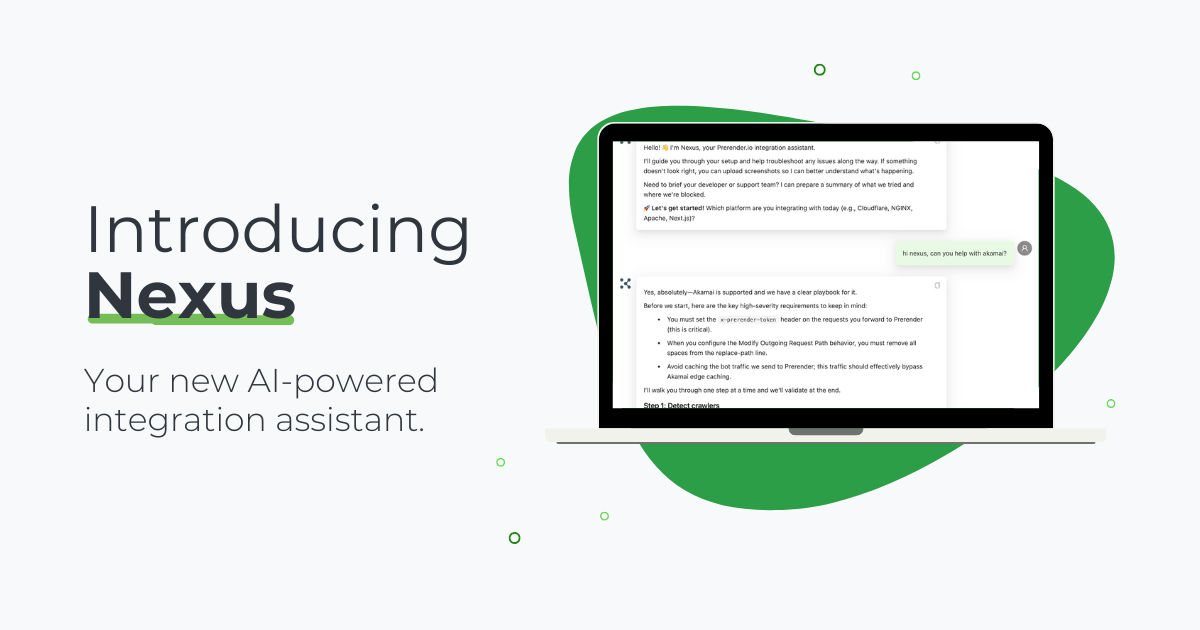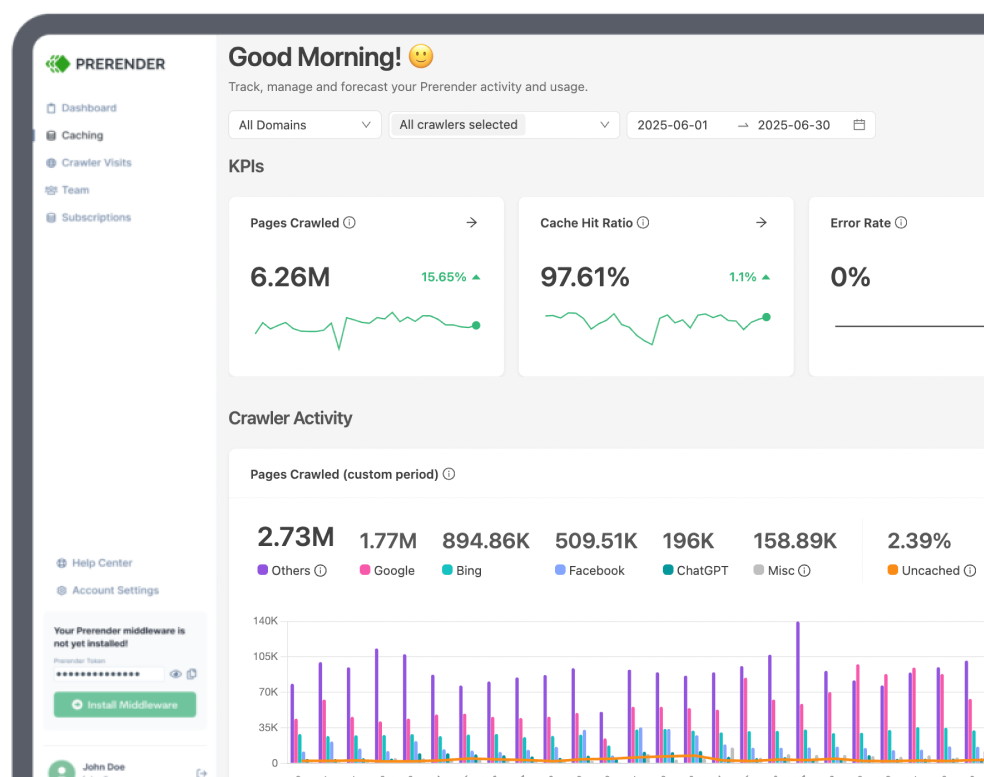A few years ago, running an SEO audit was the gold standard for checking your website’s health. You’d run a crawl, spot technical or content issues, and fix them, all to help Google properly rank your content.
But today, as AI-powered search grows alongside traditional search engines, site health checks now need an additional, important lens: a GEO (Generative Engine Optimization) audit.
Where an SEO audit asks, “Can Google crawl and rank this page?”, a GEO audit asks, “Do generative search engines understand and cite this page in their responses?”
In this article, we’ll break down the differences and similarities between SEO and GEO audits, explain what each one entails, recommend the best tools, and give you a checklist to run both audits with confidence.
What is an SEO Audit?
An SEO audit is essentially a website health check for traditional search. It is a process of evaluating how well your website is optimized for traditional search engines like Google.
From speed to structure, the goal of an SEO health check is to ensure that your site follows the best practices and to identify and fix any issues that may hurt your search ranking.
What is a GEO Audit?
A GEO (Generative Engine Optimization) audit is a newer concept focused on AI-driven search. It examines how often your site or content is cited, summarized, or linked in responses generated by large language models (LLMs) like Google Gemini, ChatGPT, and Claude.
And unlike SEO, a GEO audit’s goal is to optimize your content for generative search tools, so your site is the one presented when responding to user prompts.
Not sure if it’s time for an audit? Here are six signs your site might need one.
Key Components: SEO Audit vs. GEO Audit
Before running a proper site health check, it’s important to understand what it covers and what to look for. Let’s break down the key components of both SEO and GEO audits.
But first, remember that SEO and GEO audits aren’t two completely different practices. GEO optimization (also called AEO optimization) is built on the same foundation as SEO. The difference is that GEO emphasizes certain SEO elements and adapts them to align with how large language models (LLMs) and AI-driven search engines evaluate content.
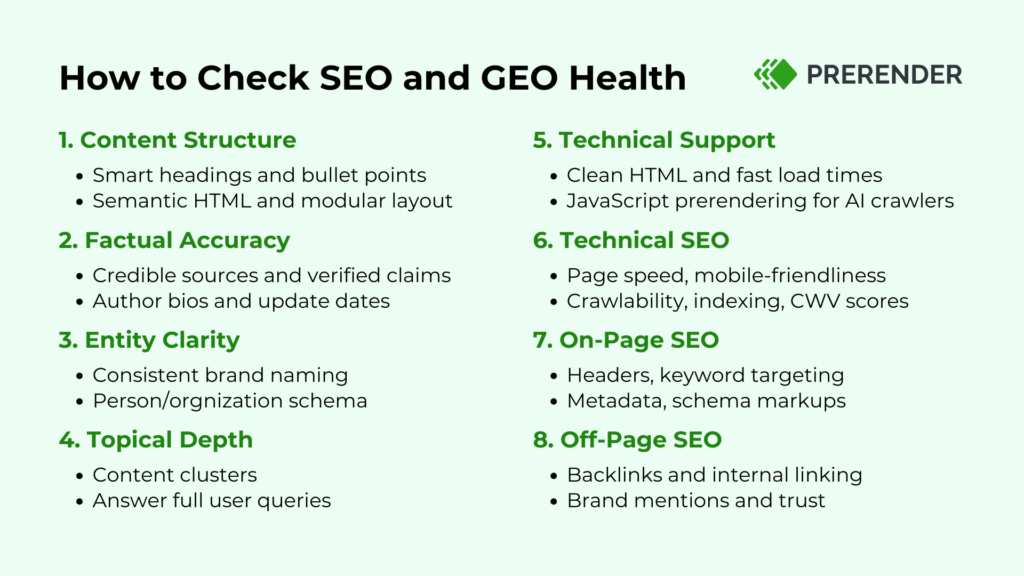
SEO Audit Checks
A solid SEO audit has many moving parts, but it can be categorized into three main areas that work together to help your site rank and stay competitive: technical, on-page, and off-page SEO. Let’s look at each of them:
1. Technical SEO
This forms the foundation of your website’s performance in search—without it, nothing else works. Technical SEO focuses on how search engines crawl, render, and index your pages. You’ll check:
- Site speed: are there slow-loading pages or JS-heavy content?
- Mobile-friendliness: does your site perform just as well on mobile as desktop?
- Crawlability: are your pages accessible to bots, or are you accidentally blocking them?
- Indexing issues: are important pages showing up in Google’s index? Or are there duplicate pages, or worse, nothing indexed at all?
2. On-Page SEO
This part of the audit focuses on making sure your content clearly communicates its purpose to both users and search engines. On-page SEO includes:
- Title tags and meta descriptions: are they compelling, keyword-aligned, and informative?
- Headers (H1, H2, etc.): is the content scannable and logically organized?
- Schema markup: are you using structured data to help search engines generate rich results?
- Keyword targeting: are you using the right terms your audience is searching for?
3. Off-Page SEO
This area evaluates how much external trust and authority your site has built across the web. It includes:
- Backlinks: are you earning backlinks from credible sources?
- Domain authority: how competitive is your site in your niche?
- Brand mentions: is your content being referenced or shared beyond your domain?
GEO Audit Checks
A GEO audit builds on traditional SEO best practices but fine-tunes them for generative search. That means the following checks apply to both SEO and GEO audits, while technical SEO, on-page SEO, and off-page SEO remain critical for measuring how your site performs in AI-powered search results.
1. Content Structure and Semantic Clarity
Since LLMs retrieve relevant, well-structured answers, this audit checks that your content is clearly organized and easy to parse
- Smart headings: are you using headings that mirror how people search or ask questions?
- Bullet points and modular chunks: is your content broken into digestible, quotable sections?
- Semantic HTML: are you using tags like , , and to help models interpret the page layout?
2. Factual Accuracy
AI models don’t point to a list of blue links, instead, they generate instant answers. This means they need high-confidence content. So your GEO audit should check for:
- Source credibility: are you linking to reputable, up-to-date sources?
- Date stamps and authorship: is your content high-quality, constantly updated, and credited to real people?
- Verified statements: are you backing up your statements with evidence and citations?
3. Entity Clarity and Brand Recognition
To show up in AI-generated answers, LLMs need to recognize your brand as a reliable entity. This, of course, starts with clear and consistent branding across your site.
- Consistent naming: are your bios, pages, and structured data aligned with the same brand identifiers?
- Trust signals: do you have an about page, author bios, and contact info that show legitimacy?
- Organization and person schema: are you using organization and person schema to help models connect the dots between your brand and your expertise?
4. Topical Authority and Depth
GEO audits care more about your coverage of a topic than keyword variety. This component checks that your site provides comprehensive, well-connected content on a subject. It checks for:
- Content clusters: are you creating related pages that link together and support each other?
- Follow-up questions: are you addressing the full range of what a user might ask?
- Comprehensive posts: are you offering real, in-depth explanations—not just surface-level content?
5. Technical Health
While a GEO/AI SEO audit is mostly content-focused, technical performance still plays a supporting role. After all, even the best content needs to be seen to be cited. So, this audit verifies that all important content is visible to AI crawlers by checking for:
- Fast-loading pages: AI-powered tools don’t wait around for slow servers.
- Bot accessibility: to prevent unintentional blockage of AI crawlers.
- Readable, clean HTML: this improves how your content is parsed and understood.
- JavaScript prerendering: to ensure that your JS-powered content is available to crawlers on request.
Recommended Tools for SEO and GEO Audits
Now that you know what to look for in both SEO and GEO audits, how can you actually check them?
Well, one powerful JavaScript SEO solution that pulls double duty is Prerender.io. With its free site audit tool, you can easily assess how well search and AI crawlers can access your content.
In addition, Prerender.io diagnoses and helps resolve technical issues by serving pre-rendered HTML for your dynamic pages, ensuring they are immediately crawlable and indexable. It also improves site speed for bots, conserves your crawl budget, and reduces the risk of your pages being skipped or partially indexed.
See how Haarshop achieved a 99 PageSpeed score and saw a 50% traffic increase after adopting Prerender.io. Read the full case study here.
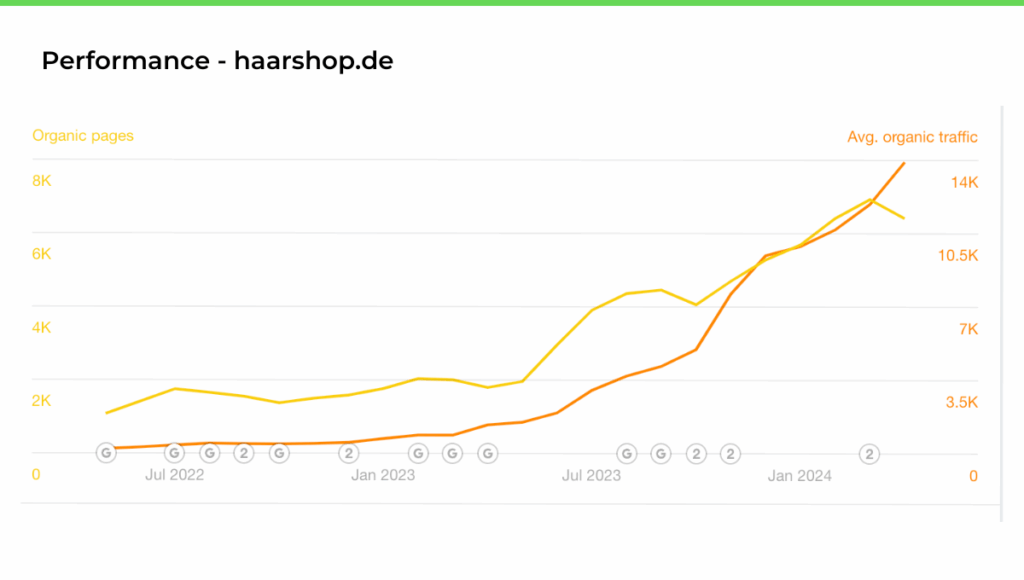
That said, below are other tools—ranging from free to paid—that can help diagnose and improve your site’s performance for traditional and AI search engines.
Note: This is not an exhaustive list. We’re only listing a handful of tools covering the key components discussed in the section above.
Tools For SEO Audits
| Tool | SEO Application | Pricing |
|---|---|---|
| 1. Screaming Frog | To crawl your site and identify technical SEO issues. | Starts at $259/year |
| 2. Ahrefs | To evaluate keyword rankings, backlink health, and expose content gaps. | Starts at $99/month |
| 3. Google Search Console | To see indexing errors, performance reports, and structured data issues. | Free |
| 4. W3C Validator | To ensure correct HTML and markup validation. | Free |
| 5. PageSpeed Insights | To evaluate load speed and Core Web Vitals for user experience and rankings. | Free |
Resource: Need more recommendations? See our top 10 technical SEO auditing tools.
Tools For GEO Audits
| Tool | GEO Application | Pricing |
|---|---|---|
| 1. ChatGPT, Perplexity, etc. | To gauge content visibility and citation in AI-generated answers. | Varies with each tool |
| 2. Frase | To highlight FAQ and summary formatting aligned with LLM output patterns. | Starts at $45/month |
| 3. Keyword.com | To track AI rankings, keywords, and brand mentions on AI search platforms, including ChatGPT, Google AI Overviews, and Perplexity. | Starts at $24.5/month |
| 4. Google Rich Results Test | To ensure structured data is valid for featured snippets and generative summaries. | Free |
| 5. InLinks | To identify entity gaps and suggest schema and internal links for clearer AI context. | Starts at $49/month |
| 6. MarketMuse | To evaluate content depth and semantic relevance using AI ranking factors. | Starts at $129/month |
Resource: Check out our top GEO tools for AI search optimization.
What LLMs Prioritize When Surfacing Content (and What They Don’t)
Even though both traditional and AI search engines aim for content visibility, the way they surface content is fundamentally different. Since LLMs are the new kids on the block, they’ll be our focus here.
Not sure how Google ranks content? Here’s a refresher on traditional SEO.
At a high-level, LLMs prioritize content that’s clear, well-structured, and context-rich. They favor conversational phrasing, helpful summaries, and topic clarity over things like keyword usage and density. If your content includes original research, statistics, or well-cited insights, it’s an added trust signal to getting referenced in AI-generated responses.
On the flip side, traditional SEO signals like meta tags, link anchors, or user experience signals tend to matter less in LLM-driven environments.
This prioritization is one of the reasons why a GEO audit is important: to ensure your content is optimized for AI models and potentially included in their answers. See our full comparison of SEO vs. AIO vs. GEO to better understand the new search landscape.
For more in-depth information and guide on your LLM optimization journey, check out these blogs:
- AI SEO Optimization: A Technical SEO Guide.
- How to Position Your Website for GEO and AI Search Success.
- 10 Tips to Help Your Products Show Up in ChatGPT.
How to Run a Technical SEO Audit and a Generative Engine Optimization Audit
If you’re ready to audit your site from both angles, here’s a brief rundown of what each auditing process looks like:
Running an SEO Audit:
- Crawl your site with Screaming Frog to get a full snapshot of how search engines see your pages.
- Use Google Search Console for crawl errors, SEO indexing issues, and performance insights.
- Review URL structure and internal linking for content clusters.
- Audit outdated, thin, or duplicate content that dilutes topical relevance.
- Evaluate technical health by checking Core Web Vitals, mobile responsiveness, HTTPS, and robots.txt.
- Analyze your backlink profile using Ahrefs or Semrush, then prioritize fixes based on impact and performance gaps.
Related: Read our guide to successful technical SEO audits.
Running a GEO Audit:
- Search your brand in tools like Gemini, ChatGPT, or Perplexity to check if your entity is properly identified.
- Test LLM prompts in your niche to see who the models cite—you or your competitors?
- Use Surfer SEO or MarketMuse to analyze your content’s structure and semantic clarity.
- Validate schema markup with Google Rich Results Test to ensure your structured data is readable and complete.
- Benchmark your visibility against competitors using Ahrefs or Semrush. Compare things like snippet ownership, domain authority, and content freshness.
- Create a GEO scorecard to evaluate your site’s visibility and overall performance in generative tools. This will help you track improvement over time.
Staying Search-Ready Means Running Both SEO and GEO Audits
It’s no secret that search behavior has changed. As many users still click search links, many others are turning to AI for instant answers. That’s why it’s no longer enough to optimize just for Google. You also need to make sure your content is optimized for and discoverable by AI search engines.
An SEO audit will help you stay compliant with technical and on-page best practices, while a GEO audit ensures your content gets cited, summarized, or linked in generative answers. Both audits are complementary and essential to your site’s health and visibility.
And if your site runs on JavaScript, a tool like Prerender.io can confidently power both audits and generative engine optimization efforts by making your content accessible to bots and AI crawlers.
With the new AI Dashboard, you can filter crawler activity by type—whether it’s search engines, social platforms, AI crawlers, or SEO tools—and see exactly how each is interacting with your site. This visibility helps you understand which crawlers matter most, what pages they visit, and where to focus your optimization efforts.
In other words, you’re not just preparing your site for today’s search engines—you’re future-proofing it for AI-driven discovery. Give Prerender.io a try to future-proof your AI search visibility.
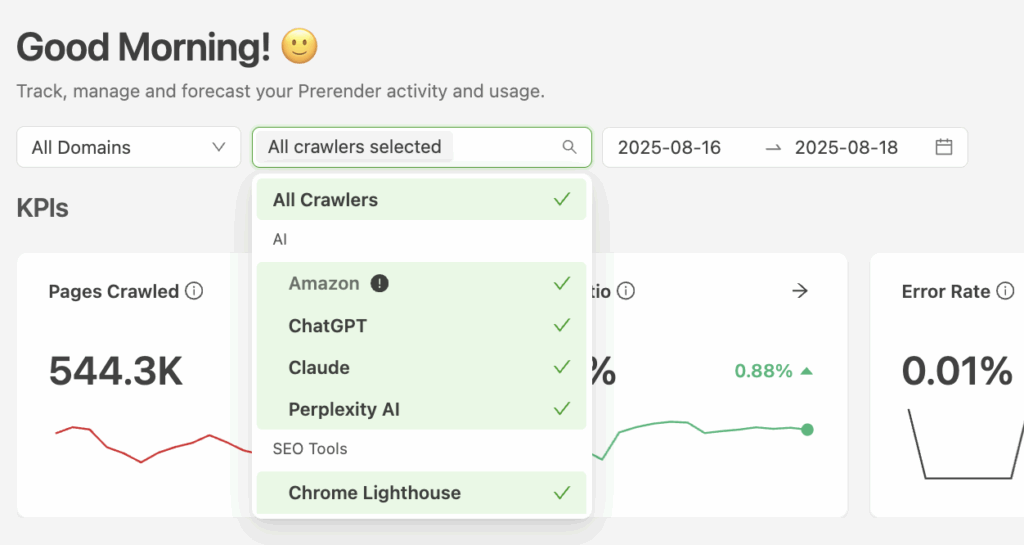
FAQs About Technical and AI SEO Audits
Let’s review some of the most common questions about technical SEO audits and newer generative engine optimization audits.
1. What’s the Difference Between an SEO Audit and a GEO Audit?
An SEO audit focuses on how traditional search engines like Google crawl, index, and rank your site. A GEO audit (Generative Engine Optimization audit) checks how well your content performs in AI search tools like ChatGPT or Google Gemini, ensuring your pages are cited or summarized in LLM-generated results.
2. How Do I Run a Technical SEO Audit for Website Health?
To run a technical SEO audit, start by crawling your site using tools like Screaming Frog or Prerender.io’s free site audit tool. Look for issues with page speed, crawlability, mobile-friendliness, and indexing. Fixing these technical gaps ensures your content can be discovered and ranked by traditional search engines—and also supports your GEO audit by making content accessible to AI crawlers.
3. How Can I Optimize My Website for AI Search Engines and LLMs?
You can optimize for AI search engines by running a GEO audit. This includes structuring your content semantically, improving factual accuracy, using schema markup, and building topical authority so LLMs recognize and reference your brand in generative answers.

